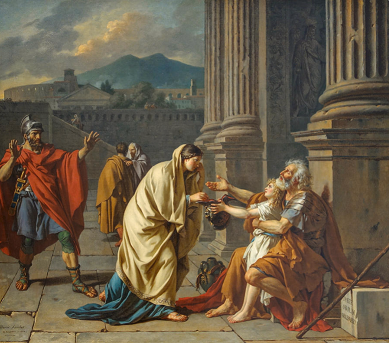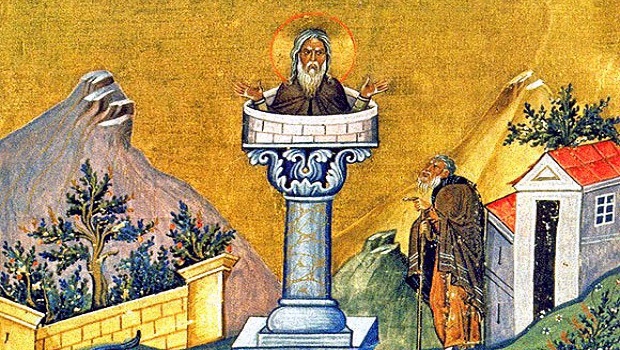In 409, a male child was born to Elias and Martha; they had been childless for a long time, after she had vowed in her prayers that if she had a child the child would be dedicated to the Lord. Since the child was born through the good will of God, they vowed that he should receive his name from God.
The child remained nameless until he was five years old when they visited a monastery and approached the igumen to provide a name for the child. The igumen opened at random one of his service books and found the name of the Prophet Daniel on the page. Thus, Martha's son received his name of Daniel. At the age of twelve he left home for a nearby monastery without his parents' knowledge.
Unknown artist
Ancient Antioch
I have no further description, at this time
While accompanying his abbot on a call by their archbishop to assemble in Antioch, the party lodged at a large monastery at the village of Telanissae where St. Symeon the Stylite lived on a pillar. There, Daniel sought and received his blessing.
At the age of 42, Daniel then left the monastery for Jerusalem and while en route traveled to see Symeon the Stylite with whom he spent two weeks. While continuing his journey to Jerusalem, Daniel met a monk on the road who convinced Daniel that he should instead go to Constantinople.
Unknown iconographer
Church of the Archangel Michael
I have no further description, at this time
Upon arrival in Anaplus near Constantinople, Daniel took residence in the Church of the Archangel Michael from which he had rid demons. Daniel was greeted warmly by Patriarch Anatolius. Soon after Patr. Anatolius fell seriously ill. He called Daniel and asked that Daniel offer prayers for him. These prayers were answered with the recovery of the patriarch.
William Burges
Saint Simeon the stylites, c. 1874
Print
I have no further description, at this time
William Burges, (born Dec. 2, 1827, London, Eng.—died April 20, 1881, London), one of England’s most notable Gothic Revival architects, a critic, and an arbiter of Victorian taste.
During Burges’s apprenticeship he studied medieval architecture, visiting the Continent to gain firsthand impressions. In 1856 he received the first award in an international competition for the Cathedral of Lille, France. He designed the Cathedral of Brisbane, Australia, in 1859 and in 1862 St. Finbar’s Cathedral of the Church of Ireland in Cork.
In 1864 Burges met the man who would be his most important patron: the passionate medievalist John Patrick Crichton Stuart, 3rd marquess of Bute. In 1865 Burges started an extensive restoration of Cardiff Castle for the marquess; he made many extensions to the existing residential apartments and directed an elaborate scheme of interior decoration, and he worked on the project until his death. In 1875 he began a similar project at nearby Castle Coch, also at the direction of his patron. Burges adopted the Victorian Gothic style for his own home (Tower House) in London (1875–80). A fellow of the Royal Institute of British Architects and an associate of the Royal Academy, he wrote architectural treatises and published (1870) his drawings. More on William Burges
After staying in Anaplus for nine years, Daniel received a vision of Symeon standing on a column above a huge pillar of cloud. Symeon declared to him, "Stand firm and play the man." After describing the vision to those around him, they counseled Daniel to mount a pillar and to take up the mode of life that Symeon had led. Several days later the monk Sergius, who was a disciple of Symeon, arrived in Constantinople bearing the news of Symeon's repose.
Sergius then decided to continue on the Monastery of Akoimetoi. En route, the sailors of the boat transporting him related a story of Daniel's victory over demons that had previously destroyed boats passing on their route. Hearing this, Sergius changed his route to visit Daniel.
Unknown iconographer
ST. DANIEL THE STYLITE AND ST. SIMEON THE STYLITE
Egg tempera, gold leaf, and gesso on wood panel
Silver halos decorated with floral borders
17.5 x 14.3 cm (6 7/8 x 5 5/8 in.)
Daniel had a pillar erected nearby, ready to assume the life of his mentor, remaining for varying periods of time on one or another of three pillars for remaining 33 years of his life. Many people came to Daniel's pillar, the sick and unfortunate as well as those seeking his blessing.
Unknown iconographer
Emperor Leo and Patriarch Gennadius paying homage
I have no further description, at this time
Among those who paid homage to the holy Daniel were the Emperor Leo and Patriarch Gennadius, as well as members of the imperial court.
In 475, during the reign of the Emperor Zeno, the senator Basiliscus usurped Leo's throne. Patriarch Acacius opposed Basiliscus, who then ventured to Daniel to obtain his blessing. Instead Basiliscus received Daniel's condemnation.
Unknown iconographer
Saint Acacius
I have no further description, at this time
With the Orthodox faith in question, Patr. Acacius begged that Daniel come down from his pillar and travel to Constantinople, to the Great Church, and confront Emperor Basiliscus on the question of his faith. Then, for the only time in his 33 years on the pillar, Daniel came down from it to travel to the Great Church, there to confront the emperor on his faith. Basiliscus affirmed his orthodoxy.
More on Saint Daniel

Jacques-Louis David
Belisarius, general of the Roman Emperor Justinian, reduced to begging, c. 1784
Oil on canvas
288 cm × 312 cm (113 in × 123 in)
Louvre
Jacques-Louis David (30 August 1748 – 29 December 1825) was a French painter in the Neoclassical style, considered to be the preeminent painter of the era. In the 1780s his cerebral brand of history painting marked a change in taste away from Rococo frivolity toward classical austerity and severity and heightened feeling, harmonizing with the moral climate of the final years of the Ancien Régime.
David later became an active supporter of the French Revolution and friend of Maximilien Robespierre (1758–1794), and was effectively a dictator of the arts under the French Republic. Imprisoned after Robespierre's fall from power, he aligned himself with yet another political regime upon his release: that of Napoleon, the First Consul of France. At this time he developed his Empire style, notable for its use of warm Venetian colours. After Napoleon's fall from Imperial power and the Bourbon revival, David exiled himself to Brussels, then in the United Kingdom of the Netherlands, where he remained until his death. David had many pupils, making him the strongest influence in French art of the early 19th century, especially academic Salon painting. More on Jacques-Louis David
Please visit my other blogs: Art
Collector, Mythology, Marine
Art, Portrait of a Lady, The
Orientalist, Art of the Nude and The
Canals of Venice, Middle
East Artists, and 365 Saints, also visit my Boards on Pinterest
Images are copyright of their respective owners, assignees or others.
Some Images may be subject to copyright
I don't own any of these images - credit is always given when due unless
it is unknown to me. if I post your images without your permission, please tell
me.
I do not sell art, art prints, framed posters or reproductions. Ads are
shown only to compensate the hosting expenses.
If you enjoyed this post, please share with friends and family.
Thank you for visiting my blog and also for liking its posts and pages.
Please note that the content of this post primarily consists of articles
available from Wikipedia or other free sources online.









No comments:
Post a Comment
Note: Only a member of this blog may post a comment.